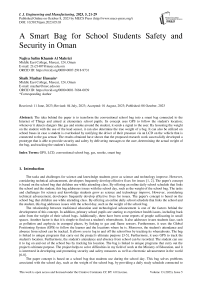A Smart Bag for School Students Safety and Security in Oman
Автор: Najiya Salim Khamis Al Mahrizi, Shaik Mazhar Hussain
Журнал: International Journal of Engineering and Manufacturing @ijem
Статья в выпуске: 5 vol.13, 2023 года.
Бесплатный доступ
The idea behind the paper is to transform the conventional school bag into a smart bag connected to the Internet of Things and aimed at elementary school pupils. Its concept uses GPS to follow the student's location; whenever it detects dangers like gas and smoke around the student, it sends a signal to the user. By lessening the weight on the student with the use of the load sensor, it can also determine the true weight of a bag. It can also be utilized on school buses in case a student is overlooked by notifying the driver of their presence via an LCD on the vehicle that is connected to the gas sensor. The results obtained have shown that the proposed research work successfully developed a prototype that is able to provide security and safety by delivering messages to the user, determining the actual weight of the bag, and tracking the student's location.
GPS, LCD, conventional school bag, gas, smoke, smart bag
Короткий адрес: https://sciup.org/15018710
IDR: 15018710 | DOI: 10.5815/ijem.2023.05.03
Текст научной статьи A Smart Bag for School Students Safety and Security in Oman
The tasks and challenges for science and knowledge students grow as science and technology improve. However, considering technical advancement, developers frequently develop effective fixes for issues [1, 2]. The paper's concept is based on the school bag that children use while attending class. By offering an online daily school schedule that links the school and the student, this bag addresses issues with the school day, such as the weight of the school bag. The tasks and challenges for science and knowledge students grow as science and technology improve. However, considering technical advancement, developers frequently develop effective fixes for issues. The paper's concept is based on the school bag that children use while attending class. By offering an online daily school schedule that links the school and the student, this bag addresses issues with the school day, such as the weight of the school bag.
The relationship between traditional education and technological advancement is one of the factors behind the development of this concept. In addition, primary school pupils are starting to experience health issues, including back ache from the weight of their school bags. Additionally, there have been some reports of people suffocating in small spaces. Another factor is that it is simple to find out a student's whereabouts. It also addresses issues students face, such as pollution and asphyxia in cramped places, by linking to gas and flame sensors. Furthermore, it uses the Global Positioning System (GPS) to follow the learner and the locations where he is. Moreover, the student's attendance and absence from school can be tracked. It allows you to log in and off the school bus by tracking its whereabouts. The bag is linked to unique programs that carry out the project's ultimate purpose [3-5]. Furthermore, it uses GPS to track the student's location. Furthermore, the student's attendance and absence from school can be recorded. The student can use it to log on and out of the school bus by tracking his location. The bag is linked to unique programs that carry out the project's ultimate purpose. The project helps to solve difficulties in my field of work at the Ministry of Education, and it is interested in developing and promoting security and safety measures as well as electronic advancement in the world [6-8].
The paper concept is based on a school bag that students use during the school day. This bag solves problems associated with the school day, such as the weight of the school bag, by providing a daily study schedule connected to the Internet, which connects the school and the student. It also addresses issues that students face, such as pollution and asphyxia in enclosed places, by connecting to gas and flame sensors [9-11].
The availability of sensors MQ2, Flame, Load sensor, LCD display (16 * 2), Node MCU esp8266, Tablet, Sim card, and bag enables the realization of the study activity and its design [12-15].
The major research objectives of this work are:
a. The timetable is sent to the students to lessen the weight of their school bags and a load sensor that measures the weight of the bag.
b. Track the locations of the students by obtaining the location from the GPS, and if a student is left inside the bus, an alarm to the driver is displayed on the LCD screen.
c. Maintaining safety from suffocation and fires by integrating the system with the MQ2 gas sensor and the flame sensor for vapors to the MCU node that sends an alarm if it occurs through a particular application that connects to the Internet inside the smart bag device.
d. Connect the bag to the gas sensor, which detects low oxygen or excessive carbon dioxide, sends a message to the LCD panel next to the driver, and sends a message to the user while the student is there to detect the forgetfulness of a student on the school bus.
2. Literature Review
The aim of this research work is to transform the conventional school bag into a smart bag for providing safety and security to the school children that are faced by them in Oman. Prior work focussed on developing a bag that can display the daily courses offered at school. Hence, the safety and security of the school kids is lacking. Prior invention focussed on managing time, displaying the courses of the day in advance, and reminding the students about the time, day, date of the courses. Hence, the prior invention focussed mainly on monitoring the courses and reminding the students in advance. We have designed a smart bag considering the ongoing problem in Oman with respect to the children’s protection from violence in all settings. We claim that the proposed research will address the issues related to school children safety, security, and health concerns due to heavy school bags that can develop back pains, muscle fatigue, tiredness, and also reduced concentrations.
The first section contains an introduction to the research. It is a smart bag designed to keep you safe from threats and track your location. The literature review, which deals with prior publications associated with the title and summary of the study, is included in Chapter 2. Chapter 3 discusses system design and analysis," which included a block diagram, a flowchart with an explanation, and the software and hardware requirements. Chapter 4 concludes the work followed by the references.
This section will identify the gaps, inconsistencies, limitations, and techniques used from the existing works.
The purpose of [3], is to help elementary school pupils organize their personal stuff in a school backpack. Users including teachers, parents, and students can keep track of a daily schedule of a list of school supplies using specially built sensors and a tablet hidden within the students' backpacks. The bag's contents are all listed and identified. When a student forgets or loses one of the items in the bag, the previous device compares with the prior device and prompts them to remember. Additionally, each item has a study program attached to it. Fifty primary school students were interviewed as part of the study's methodology to learn about their perceptions of the school bag system and how it affected their conduct. Additionally, 30 students were asked to test the method with their parents and then complete a multiple-choice questionnaire. NVivo 9 and SPSS were used to analyze the interview transcripts and survey results. One of the interview's most significant findings was the participants' astonishment that the smart school bag could converse and give users interactive and reminder responses. Other service reminders, such as water cans, lunch boxes, and athletic apparel, were recommended by the participants. According to the survey, 90% of parents and 100% of kids agreed that the school bag helped them remember what they needed to bring to class. Additionally, it assisted in lighting the load on their backpacks. On the other side, more than 30% of parents of students are concerned that their child's use of the intelligent bag would eventually damage their personality.
Due to the tracking sensors, they include smart bags offer security against theft [4]. Furthermore, such technology should demonstrate that it has no adverse effects on the usage's normal function and aesthetic aspects. For the smart bags to satisfy the owner's preferences, they must continue to be lightweight, trendy, and built of materials resistant to weather and water. The development of smart wearables reflects technological progress. Thus, including network antennas in smart bags is not surprising, given that this technology might enhance communication between the bag and the owner's mobile device. This might be accomplished using a variety of network types, including Bluetooth and Wi-Fi.
The owner gains various advantages from the connectivity between the smart bag and phone, including the ability to ascertain the bag's contents and get data from the sensors built into the bag [5]. The smart bag may also have a personal safety feature that used sensors to detect the movement of surrounding moving cars and other inanimate objects as well as moving people and animals. Personal health care applications that include user body temperature and heart rate monitoring are also fascinating. All of this data is gathered by the smart bag's sensors and shown to the user on their smartphone.
The smart bag is made of intelligent materials that work well with electronic components because they preserve the electronics without impairing their functionality. Additionally, a solar panel is integrated into the bag's exterior to enable the electrical charging of the internal circuits. Through a connected connection, this electricity will power up the Motherboard, the main electronic circuit inside the bag, turning on its functional functions like the GPS, heating system, and camera. The internal memory and internet cloud are then used to store the data that these features acquire [7]. The Node mcuESP8266 is the first controller of inputs and outputs, such as sensors, and it is open source and can be configured according to the target, primarily since it supports Wi-Fi. This article discusses the significance of the Node mcuESP8266 in IOT applications. It stands out for being affordable and supporting local networks and Internet applications.
3. System Design and Analysis
The input and output units are thoroughly addressed in the first section, System Analysis, which is divided into two parts: a block diagram and a flow chart. System Design is the second subsection. Hardware and Software Requirements is the last section.
The developed prototype can be used mostly in schools, school buses, nurseries, airports, and houses; also it can be used in enclosed spaces such as factories where toxic chemicals and gases may be present.
-
3.1. Methodology
The block diagram of the system is shown in Fig.1 and 2. There are five main functions in the system. The MQ2 sensor is attached to the esp8266 Node, detecting gases, and issuing a red alarm. The flame sensor picks up on nearby fires and sends a signal to the Node MCU esp8266, determining whether there is a flame. The load sensor, another input attached to the MCU esp8266, provides the bag's weight to the Node to assess whether it is normal or excessive. The system's MCU esp8266, which determines the situation in the design, is its brain. The system's outputs include an LCD, a tablet, and an IOT. As we can see in the diagram, there are several components, each with a particular purpose in the design. A flame sensor that detects fires in less than a second using infrared (IR) or ultraviolet (UV) radiation and sounds an alert or flashes a red light. When the MQ2 sensor detects gas or smoke, it flashes red or emits an alarming sound. By pressing the bag's contents against its internal spring, the load sensor measures the weight there and sends the information to the Node Mcu if the required limit is exceeded. The brain of the design and controller of the other components is Node McuESP8266. It determines the commands and programs that are necessary. It has Wi-Fi connectivity and is ideal for the Internet of Things. The outputs are IoT, GPS, mobile systems, and LCD.
-
3.2. System flowchart
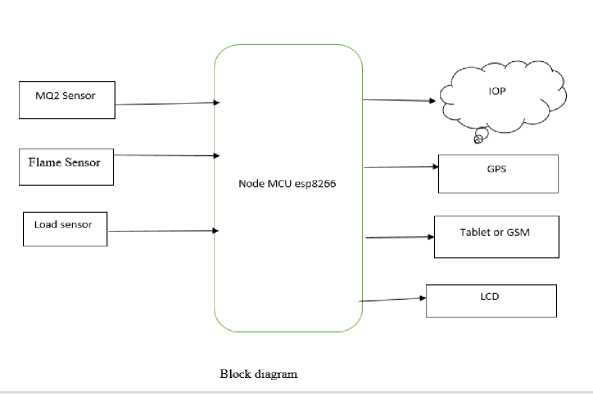
Fig. 1. System blockdiagram
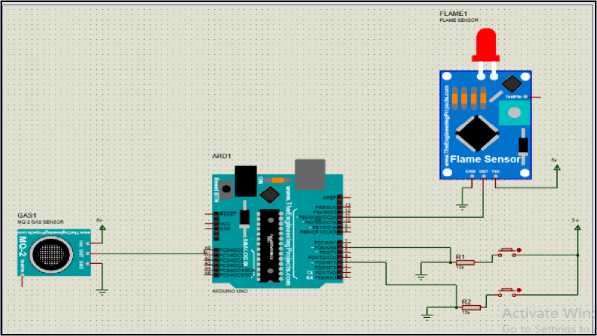
Fig. 2. Proteus design
A flowchart of MQ2 in the project design is shown in Fig.3. The process begins with the gas sensor. If it detects gas in the environment, it sends an online warning message to the user and displays the result on the system's LCD screen. In the case of the other response, no, a loop continues indefinitely in a circular fashion.
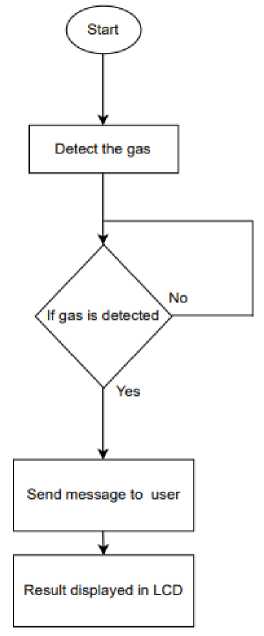
Fig. 3. System flowchart
-
3.3 System simulation, testing, and implementation
This section will go through the functional properties of the circuit and the application. It features a circle simulation in the Tinker cad application. It also contains the following sections:
Before beginning the implementation of the project circuit, it is helpful to simulate circuit functionality to confirm that it is functioning as expected. I used the tinker cad application to simulate a circuit, a free online 3D modeling program that runs directly in the browser. The simulation begins by connecting the Arduino to all components based on the voltage and current required to run the circuit. Figure 4 depicts the tinker cad simulation circuit.
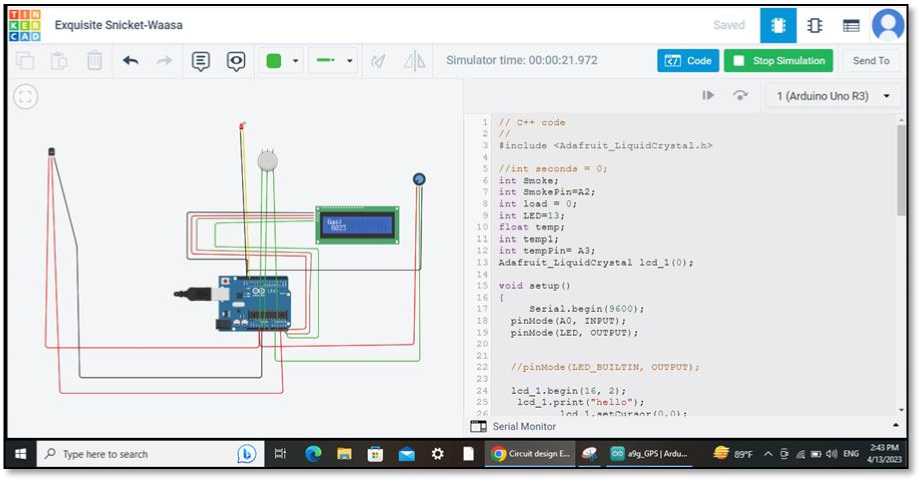
Fig. 4. System schematic diagram
As illustrated in Fig.4. , all components have been correctly connected to the Arduino to acquire the desired results from the circuit simulation in the Tinkercad tool, which operates directly on the site. The circuit includes the Arduino Uno, LCD, MQ2 sensor, potentiometer, LED, and temperature sensor (TMP36). Due to their absence in the program, some of the pieces were changed with other pieces that fulfill the same role, as seen in the circuit. A potentiometer that measures weight has taken the place of the load sensor.
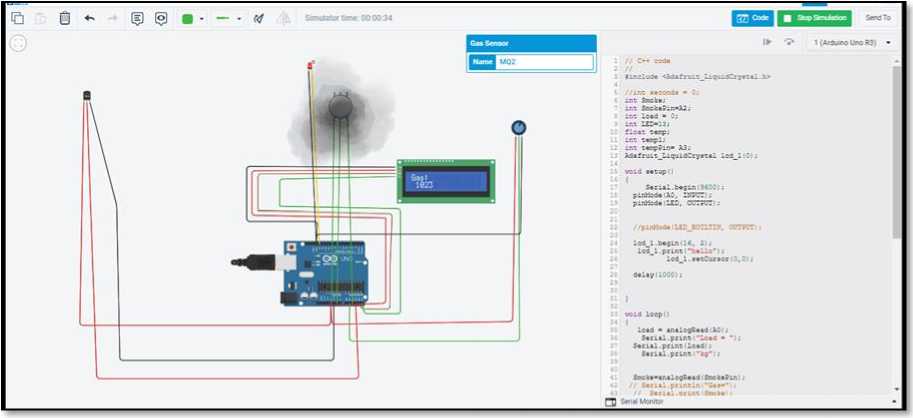
Fig. 5. System schematic diagram
-
Fig.4. depicts a schematic diagram of the system during simulation, in which the code is placed into the program as Fig.4. and pressed to begin the simulation. The presence of fumes is increased, indicating a gas sensitivity from the MQ2 sensor, as shown on the LCD screen. There is also a red light in the LED that does the task of A9G in the system, which tracks Location and GSM Connection. Readings for the temperature sensor and potentiometer, which the flame sensor and friendliness sensor have replaced, also display in the serial monitor, as illustrated in Fig.5. Table 1 displays the simulation values of voltages in tinker cad, which estimate actual values and refer to integer values in real prototype work to achieve project goals. As a result, the error percentage is low, implying that the output accuracy is good or close to the values shown in Fig.6.
Testing
Components
Design value
Simulation value
Implemented value
T1
LCD screen
3-5V
5V
4.23V
T2
Load sensor
5-10V
5V
4.63V
T3
Flame sensor
5V
1.74V
4.20V
T4
MQ2 sensor
3-5V
5V
3.24V
Table 1. Testing
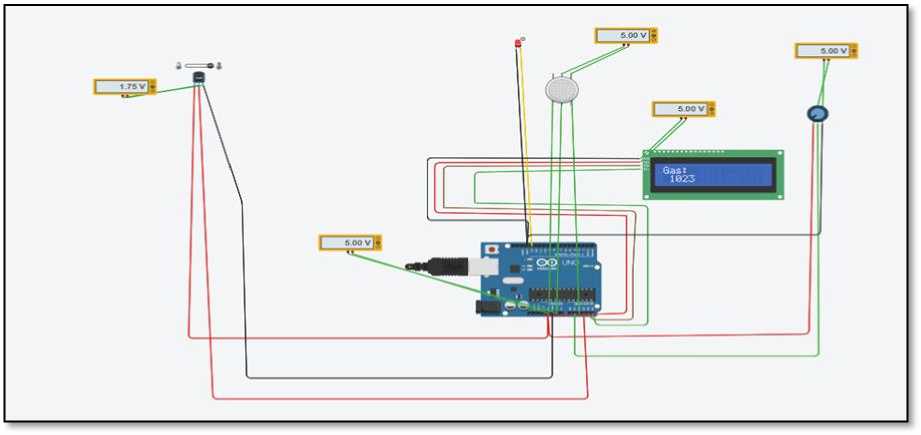
Fig. 6. The voltage values during simulation
Table 2 displays multimeter readings of voltage values for each component when connected independently to the circuit and when coupled with all of the circuit's components. I noticed this by taking voltage values close to or equal to the readings in both circumstances when the component is isolated or when it is integrated with all of the components of the project's electrical circuit. As illustrated in the figures below:
|
Test |
Component |
separate value |
Combined value |
|
T1 |
Load Sensor |
4.63V |
4.63V |
|
T2 |
LCD Display |
4.2V |
4.23V |
|
T3 |
Flame Sensor |
4.68V |
4.20V |
|
T4 |
MQ2 Sensor |
4.4V |
3.24V |
Table 2. Testing
Figure 9 depicts the smart bag's final electrical circuit, consisting of the controlling mind, node MCU sep8266, MQ2, two loads, flame sensors A9G (GSM/GPRS+GPS) module, and LCD. As shown below, I attached the MQ2 sensor to the node MCU, connecting pin A0 to A0 for the node, VCC to VCC, and ground to ground. In addition, I joined the flame sensor to the node MCU as follows: pin D with D6 for the node, VCC with VCC, and ground with the ground. In addition, I linked the two load sensors to a hx711 amplifier, which was then linked to node MCU. Following that, I connected the LCD to the node as follows: DT with D4, SCK with D5, VCC with VCC, and ground with the ground. Finally, I wired A9G to the node as follows: Rx with D3, TX with RX, VCC with VCC, and ground with the ground. It was then given a SIM card to carry out the process of sending SMS, contacting the user, and tracking his whereabouts. Then, using a USB cable, connect the node MCU esp 8266 to the laptop. The code is uploaded into the Arduino IDE application, which has previously downloaded all of the circuit component libraries. Furthermore, the code is linked to the Blynk software, which allows changes in readings to be tracked directly via a particular user account that can be downloaded to the phone. According to the following, each circuit component accomplishes a particular purpose. The LCD alerts the driver if a pupil aboard the bus needs to be remembered. The phrase "there is someone on the bus" is written on it. When the CO2 level in the area rises, the MQ2 gas sensor is programmed by A9G to contact the driver. The A9G also obtains the student's location by SMSing the parents during the day.
Fig. 9. Circuit diagram
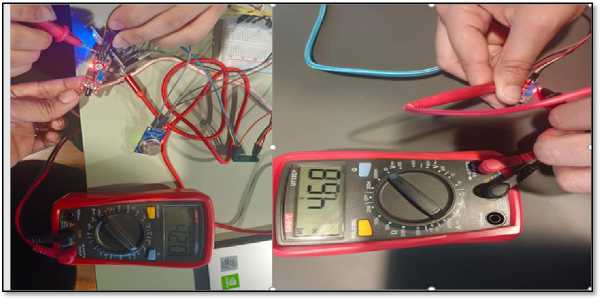
Fig. 7. Test point of flame before and after combination
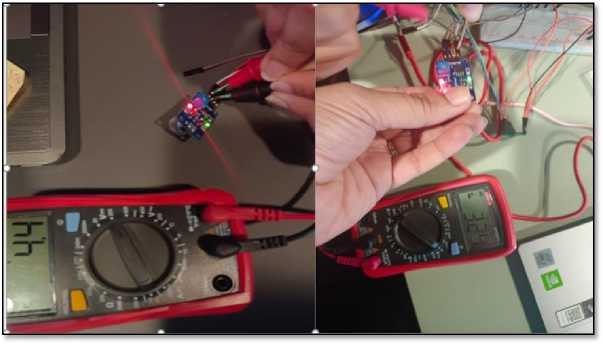
Fig. 8. Test point of MQ2 before and after combination
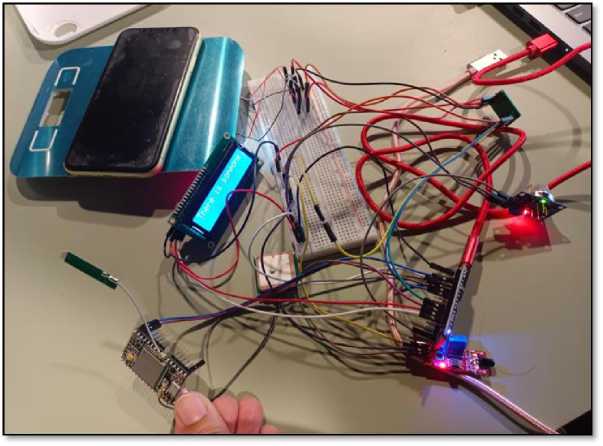
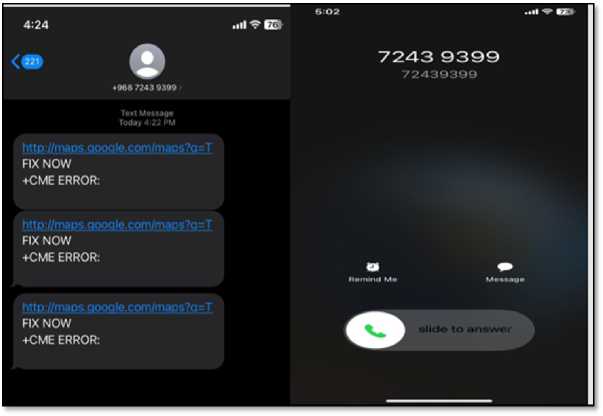
Fig. 10. SMS and call from A9G
The load sensor is also set to compute the weight of the contents of the bag. The system sends an SMS to the parents once it surpasses 5 kilometers, as seen in Fig.10.
4. Conclusion
We have designed a smart school bag that overcomes the traditional school bags for school kids and outperforms the existing works,
We claim the following features of the smart school bag,
-
i. Tracking the location of the student
-
ii. Sensing the toxic gases around the student and alerting the parents or loved ones
-
iii. Measuring the actual weight of the bag and notifying the parents
-
iv. Sending information to the driver if a student forgets to get off the bus and sleep on the bus.
The research paper helps the Ministry of Education solve challenges. Simultaneously, it is focused on creating and improving global security, safety, and electronic progress techniques. It protects children's health, particularly those in primary school, by reducing the bag's weight, which harms health. Keep the students safe from suffocation and flames as well. Parents can accompany their children to school. This research is most used in schools, school buses, nurseries, airports, and residences; however, it can also be used in enclosed spaces such as factories where toxic chemicals and gases may be present.
This smart bag is intended to be controlled by IOT based on the requirement of kids and their parents to minimize the bag's weight through the presence of a sensor that determines the actual weight of the bag to preserve their health. It seeks to achieve another goal, which is to keep kids safe from flames and gases by incorporating sensors that accomplish this. The design also considers performing and tracking students' positions by attaching the bag to GPS coordinates to detect their whereabouts.
Another purpose is reached by linking the exit and entry of the student on the bus with the driver via an LCD, which allows the driver to know if any student has forgotten on the bus. Where necessary, plans were made and prepared to advance the design and achieve these goals regarding the system's primary components and the programs that support the system's design. Because technological advancement is infiltrating the world daily, this design can be enhanced in the future by broadening the scope of usage, such as adding sensors that care about health, such as temperature, pressure, heart rate, and other items of health concern.
Acknowledgment
The author would like to acknowledge Middle East College for providing wonderful facilities in completing this research work. Further deep gratitude to my supervisor for his outstanding supervision and guidance.
Список литературы A Smart Bag for School Students Safety and Security in Oman
- Varshney, V. (2018, March). (PDF) solar powered smart bag - researchgate. www.researchgate.net. Retrieved December 29, 2022, from https://www.researchgate.net/publication/324683398_Solar_Powered_Smart_Bag
- Gajbhiye, Hedau , Badge, Kadu, Pradhan, E. S. , M. , M. P. , A. (2020). Multipurpose smart bag - IJARIIE. ijariie. Retrieved December 29, 2022, from https://ijariie.com/AdminUploadPdf/Multifunctional_Smart_Bag_ijariie12676.pdf
- Alshamrani, F., & Abdel Basset, N. (2021, March 1). Ergonomic design of smart bags: An analytical study. mjaf.journals. Retrieved December 29, 2022, from https://mjaf.journals.ekb.eg/article_127528.html?lang=en.
- Meena, M. (2016, May). (PDF) smart school bag - researchgate. researchgate. Retrieved December 29, 2022, from https://www.researchgate.net/publication/318850875_Smart_School_Bag.
- Hussain, S. M., Yusuf, K. M., & Hussain, S. A. (2017, December). A conceptual framework on IOT based system designto prevent road accidentsin accident prone cities. In 2017 International Conference on Infocom Technologies and Unmanned Systems (Trends and Future Directions)(ICTUS) (pp. 205-210). IEEE.
- Admin, E. D. (2020, June 18). Ir Infrared Flame Sensor Module: How fire sensor works " electroduino. ElectroDuino. Retrieved December 30, 2022, from https://www.electroduino.com/ir-infrared-flame-sensor-module/
- Al Balushi, I., & Hussain, S. M. (2021). IoT Based Air Quality Monitoring and Controlling in Underground Mines. Journal of Student Research.
- AL-Sakiti, M. K., & Hussain, S. M. (2021). IoT based monitoring and tracing of COVID-19 contact persons. Journal of Student Research.
- Kodali, R. K., & Yerroju, S. (2017). Ravi Kodali | National Institute of Technology, warangal ... - researchgate. IoT Based Smart Emergency Response System for Fire Hazards. Retrieved December 31, 2022, from https://www.researchgate.net/profile/Ravi-Kodali
- WatElectronics. (2022, October 27). Flame sensor: Working, types, interfacing & its applications. WatElectronics.com. Retrieved December 31, 2022, from https://www.watelectronics.com/flame-sensor/
- Hussain, S. M., & AL HABSI, N. S. N. S. (2021). Protection of foodstuffs in storage warehouses system. Journal of Student Research.
- Al Mawali, A. A. A., & Hussain, S. M. (2023). Automated Wall Painting Robot for Mixing Colors based on Mobile Application. International Journal of Engineering and Manufacturing, 13(1), 33.
- Hussain, S. M., & Al Saadi, E. A. S. N. (2021). Voice enabled Elevator system. Journal of Student Research.
- Sarkar, S., Manna, S., & Datta, S. (2017, December). Smart bag tracking and alert system using RFID. In 2017 International Conference on Electrical, Electronics, Communication, Computer, and Optimization Techniques (ICEECCOT) (pp. 1-4). IEEE.
- Varshney, V., Jha, P., Tiwari, M. N., & Gupta, D. (2017). Solar powered smart bag. Proceeding of the 12th INDIACom.

